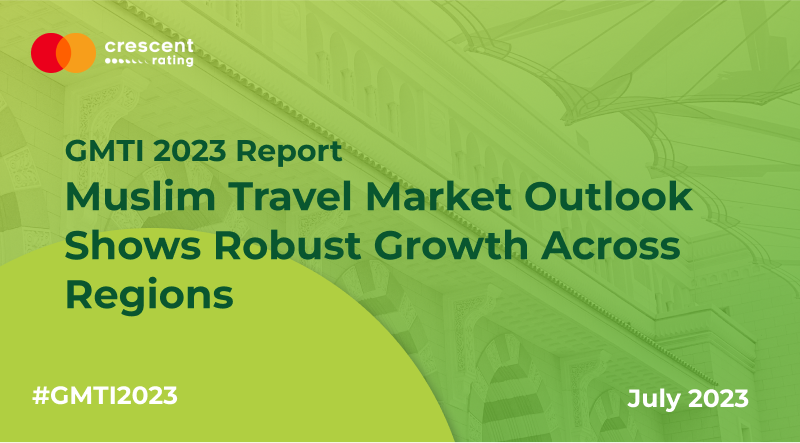
In the aftermath of the COVID-19 pandemic, the Muslim travel market has emerged as a beacon of hope for the global travel industry, exhibiting resilience and robust growth. The recently released Global Muslim Travel Index (GMTI) 2023 report by Mastercard-CrescentRating, sheds light on the promising recovery trajectory of this sector. With projections indicating an upward trend in Muslim arrivals and their economic significance, the market is poised to reach unprecedented heights, surpassing pre-pandemic levels.
The GMTI 2023 report reveals that the Muslim travel market is on a steady path to recovery. In 2022, Muslim international arrivals reached 110 million, which accounted for 68% of the 2019 pre-pandemic levels. This remarkable rebound is a testament to the willingness and ability of Muslim travelers to resume international journeys as travel conditions improve.
Looking ahead, the projections for 2023 forecast a further rise in Muslim arrivals, reaching 140 million, equivalent to 87% of the 2019 levels. This continued growth is indicative of the sector's recovery process gaining traction. By 2024, a full recovery is anticipated, with the total Muslim arrivals set to match the 2019 figures of 160 million. This milestone signifies a complete recovery and revival of the Muslim travel market.
The GMTI 2023 report provides an optimistic glimpse into the future of the Muslim travel market. By 2028, Muslim arrivals are projected to reach an unprecedented high of 230 million. This figure represents a significant increase from the 2019 levels, signifying that the growth of the Muslim travel market is not just limited to recovery but also an expansion.
Beyond the arrival numbers, the report highlights the economic significance of this market segment. By 2028, Muslim travelers' expenditure is projected to reach USD 225 billion, underlining their potential to contribute significantly to the global travel industry's recovery and growth.
The GMTI 2023 report delves into a comparative analysis of global and Muslim travel arrivals by region, revealing intriguing trends and preferences among Muslim travelers.
With over 31% of arrivals being Muslim travelers, Asia stands as the leading destination for the Muslim travel market. This comes as no surprise, given the region's substantial Muslim population, particularly in Southeast Asia and the Middle East. Additionally, Asia's offerings of Muslim-friendly travel options cater to diverse travel preferences, making it a preferred choice for many. The proximity of destinations and the impact of higher airline prices after the pandemic have also influenced travelers' preferences to opt for nearby destinations rather than long-haul trips.
Despite having relatively lower international arrivals overall, Africa impressively captures more than 21% of Muslim travelers. This indicates that Africa holds a significant appeal for Muslim travelers due to its rich cultural diversity, historical Islamic heritage, and substantial Muslim populations, especially in North Africa. As African nations increasingly recognize this market's potential, there is ample room for growth in better accommodating Muslim travelers.
Although Europe boasts the highest number of global arrivals, it accounts for a relatively smaller proportion of Muslim arrivals, at around 6%. This disparity suggests an opportunity for growth in accommodating Muslim travelers. Europe's popularity as a travel destination, combined with its diverse offerings, presents a valuable opportunity for the region to enhance its Muslim-friendly facilities and further attract this emerging segment of travelers.
With the smallest global arrivals, Oceania also has a smaller share of Muslim travelers, approximately 7%. The geographic distance between Oceania and many Muslim-outbound markets has influenced this trend. Nevertheless, the figures indicate the potential for improvement in attracting and accommodating Muslim travelers as the region works towards enhancing its offerings and accessibility.
The Americas currently host the smallest proportion of Muslim travelers, accounting for just 2% of the total arrivals. Factors such as distance, travel costs, and perceived lack of Muslim-friendly facilities have contributed to this low figure, particularly in South American destinations. However, the data also signifies the untapped potential for growth in the Muslim travel market, as the region acknowledges and adapts to the preferences of Muslim travelers.
The GMTI 2023 report offers a comprehensive assessment of the Muslim travel market's trajectory, demonstrating its resilience and robust growth after the setbacks of the COVID-19 pandemic. With projections pointing towards a bright future, the market's continued expansion presents opportunities for various regions to embrace and cater to the preferences of Muslim travelers. By understanding and embracing this segment's cultural diversity and unique needs, the global travel industry can position itself for a more inclusive and prosperous future. The rise of the Muslim travel market is not only a sign of recovery but a testament to the power of diversity and inclusivity in shaping the future of travel.
Visit this link to download the GMTI 2023 full report!